We like to think of the barbarous as 'the other', but really a barbarian is inside all of us.
Don't wanna be here? Send us removal request.
Text

~ Children's Toy - Сockerel.
Place of origin: Karachay-Cherkessia, Russia
Culture: Early medieval culture of the Adygo-Alanian tribes
Date: A.D. 8th-9th century
Place of origin: North-western Caucasus, Karachayevo-Cherkessk Republic; Archaeological site: Moshchevaya Balka Burial Mound
Medium: Leather, thread, silk.
911 notes
·
View notes
Text
Last meal of ancient human sacrifice victim 'Tollund Man' revealed in exquisite detail

Shortly before his violent death in 400 B.C., a man — whose remains are known as Denmark’s famous bog body “Tollund Man” — ate a meal of porridge and fish, a new study finds.
Tollund Man also had several parasitic infections from whipworms and mawworms, as well as the first reported case of tapeworm ever found in an ancient body preserved in a bog, said the researchers, who made the finding by studying a piece of Tollund Man’s colon.
“We have been able to reconstruct the last meal of Tollund Man in such great detail that you can actually recreate the meal,” study lead researcher Nina Nielsen, an archaeologist and head of research at Museum Silkeborg in Denmark, told Live Science. “That’s quite fascinating, because you can get so close to what actually happened 2,400 years ago.” Read more.
663 notes
·
View notes
Text
New Sarmatian Burial Mound Found in Russia
The Sarmatians were a large Iranian steppe people who formed a coalition, dominated the related Scythians, and became masters of the Eurasian steppe from about 200 BCE to about 300 CE. Rustam Mudayev, a Russian farmer, recently discovered a burial mound after noticing a bronze cauldron while working on a farm northwest of the Caspian Sea. Mudayev reported the discovery to authorities, and the mound was excavated by an archaeological team from the Astrakhan State Museum, who identified it as a Sarmatian burial.
The Sarmatian burial mound, or kurgan, had been looted in antiquity. But the looters left behind three human skeletons in wooden coffins, a horse skull, a harness, weapons, gold jewelry, and a bronze cauldron.
Investigations of the remains indicate they died about 2,500 years ago. That is a little early for the Sarmatians. Their culture was believed to have coalesced by about 300 CE – two hundred years after this kurgan burial. This might help us better understand who the Sarmatians were before they became dominant and entered western historical records.
237 notes
·
View notes
Note
question: it bothers me a bit when scholars refer to tribes as Scythians, Sarmatians, etc. given that these are (afaik) Greek terms that don't seem likely to be related to the terms these groups had for themselves. Is it pretty much always the case that those names (or even the terms that more local neighbors used for them) are entirely lost to history? To what extent is this just scholars going along with the established academic norm?
It’s a complicated mix. The peoples of the steppe were not a particularly literary people, and so almost everything we know is either based on archaeological or based on sources, largely a mix of Greek (and later Roman,) Persian, or Chinese, with a few other ones. In many cases, though, even the terms Scythian, Sarmatians, and so on are a somewhat iffy, more a broad designation. Indeed, even Greeks as far back as Herodotus used it as more an ethno-cultural label rather than a specific tribe, much in the way folks use, well, Greek despite various city-states being divided and so on, or for that matter the way German was an ethno-cultural designation long before it was a state.
Indeed, that bleeds off into a topic that is interesting that I may need to do a post on, about how the term nation is not the same as a government or state, and indeed that’s why the term nation-state exists, yet there has been an intentional conflation of the two over time, but I digress.
Saka was the term the Persians used for the Scythian tribes, either in general or nearest to them, it’s not entirely clear. That term has versions in Greek, Latin, Persian (obviously,) and also Chinese, and may be linked to an endonym but it’s hard to say.
It’s not until we get groups like the Alans that true endonyms seem to return, though that may hint, actually, at what they may have called themselves. You see, Alan derives from Arya or Aryan, from whence we also get Iranian and Iranic. Though the term is, unfortunately, associated with Nazi rhetoric in a lot of folks mind, it is a legitimate self-designation and applies to the various steppe peoples and their descendants, including the Persians and some groups in India as well.
Notable, though, on the topic of academic norms, post WW2 there was a lessening of the use of Aryan due to its connotations.
In most cases, though, it’s simply a matter of working with what we have, to designate specific groups. It’s a step above, say, the use of things like ‘Corded Ware culture’ or ‘Timber Grave culture’ because we lack really any other designation for the group. It also gets into specifics.
It’s also a bit better than my personal pet peeve of the use of Wales and Welsh, over Cymry or other terms, because of the origin of the term Wales. In many ways, use of Wales or Welsh is comparable to the use of the term ‘Indian’ or ‘American Indian’ in the US, seeing as both were invaded by the Brits and pushed off their land.
90 notes
·
View notes
Photo


Sarmatian iron sword, 4th - 2nd century BC
from Karabela Auctions
466 notes
·
View notes
Photo

Transenna Post, 700s-800s, Cleveland Museum of Art: Medieval Art
In Christian architecture a transenna is an openwork screen of stone or metal enclosing a shrine. These transenna elements were found in Rome; the posts were said to have been excavated on the Coelian Hill and may have originally formed part of the transenna of the Church of San Saba. The Lombards were an ancient Germanic-speaking tribe that settled in Italy after 568. Their artistic tradition was originally centered on small objects of personal adornment like buckles and brooches. After occupying Italy, the Lombards found themselves in contact with large-scale sculpture of classical and early Christian origin that, by the end of the 700s, they had learned to adopt and imitate, as seen here. Size: Overall: 110.1 x 28.6 cm (43 3/8 x 11 ¼ in.) Medium: marble
https://clevelandart.org/art/1920.284
22 notes
·
View notes
Photo

Drawing The Battle of Teutoburg 9 a.d.
41 notes
·
View notes
Photo

Settlements of the Angles, Saxons, and Jutes in Britain around 600 CE.
191 notes
·
View notes
Text
Ancient genomes trace the origin and decline of the Scythians
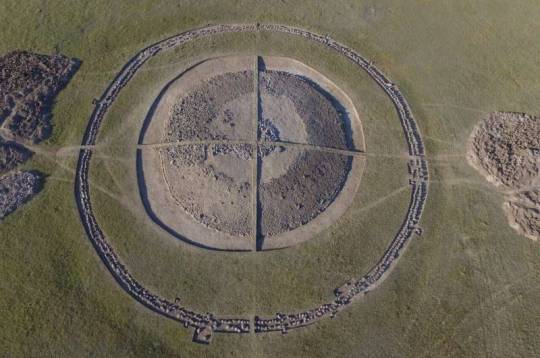
Generally thought of as fierce horse warriors, the Scythians were a multitude of Iron Age cultures who ruled the Eurasian steppe, playing a major role in Eurasian history. A new study published in Science Advances analyzes genome-wide data for 111 ancient individuals spanning the Central Asian Steppe from the first millennia BCE and CE. The results reveal new insights into the genetic events associated with the origins, development and decline of the steppe’s legendary Scythians.
Because of their interactions and conflicts with the major contemporaneous civilizations of Eurasia, the Scythians enjoy a legendary status in historiography and popular culture. The Scythians had major influences on the cultures of their powerful neighbors, spreading new technologies such as saddles and other improvements for horse riding. The ancient Greek, Roman, Persian and Chinese empires all left a multitude of sources describing, from their perspectives, the customs and practices of the feared horse warriors that came from the interior lands of Eurasia. Read more.
#article#science#the scythians#the eurasian nomads#scythian history#history#eurasian nomadic history
813 notes
·
View notes
Text
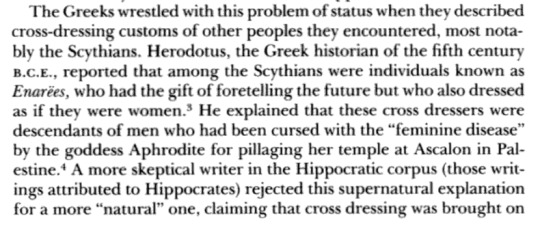
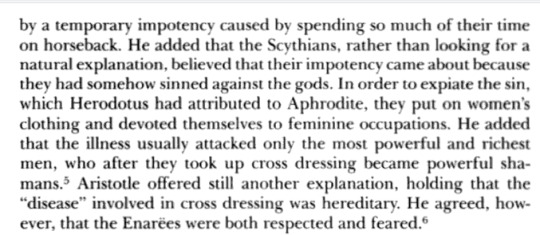
from: Cross Dressing, Sex, and Gender - Vern L. Bullough, Vern L.. Bullough, Bonnie Bullough
36 notes
·
View notes
Photo
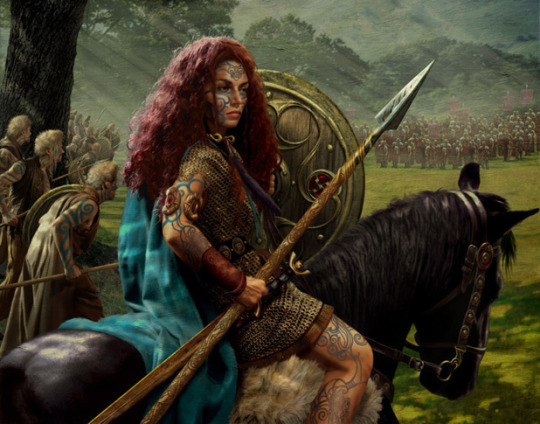
Boudica Warlord and queen of the British Iceni, an ancient Celtic tribe, Boudica led an uprising against the occupying forces of the Roman Empire. Boudica’s husband Prasutagus was ruler of the Iceni tribe, and enjoyed autonomy under a treaty with the Romans. However, when he died, the kingdom was annexed as if conquered. Boudica was flogged, her daughters were raped, and Roman financiers called in their loans. In AD 60 or 61, Boudica waited until the Roman governor Gaius Suetonius Paulinus was leading a campaign on the island of Anglesey off the northwest coast of Wales. She then launched a massive assault leading the Iceni, Trinovantes and other Britons in revolt against Roman population centers. She destroyed Camulodunum (modern Colchester), and while the out-manned Roman garrisons attempted to flee, Boudica’s army of 100,000 engaged the Legio IX Hispana, decimating them, then burned and destroyed Londinium, and Verulamium (modern-day St. Albans). An estimated 70,000–80,000 Romans and British were killed in the three cities by Boudica’s armies. Despite these early gains, Suetonius regrouped his forces in the West Midlands, and though heavily outnumbered, defeated Boudica’s advancing Britons in the Battle of Watling Street. The crisis caused the Emperor Nero to consider withdrawing all Roman forces from Britain, but Suetonius’s eventual victory over Boudica confirmed Roman control of the province. Boudica then killed herself so she would not be captured. She has since remained an important cultural symbol in the United Kingdom, and is renown for her tactical use of the chariot on the battlefield by employing shock-combat to break enemy formations.
3K notes
·
View notes
Photo

80 notes
·
View notes
Photo

Piece from a Luxury Dagger, Metropolitan Museum of Art: Medieval Art
Purchase, 1895 Metropolitan Museum of Art, New York, NY Medium: Gold
http://www.metmuseum.org/art/collection/search/469018
33 notes
·
View notes
Photo

Varangian guard and Rus mercenaries, Angus McBride, 1979
241 notes
·
View notes
Photo

Migration Period Sword Hilts
352 notes
·
View notes
Photo


~Belt Buckle. Date: c. 525-560 Place of origin: Visigothic, Iberian Peninsula Period: Migration period
#the visigoths#visigothic clothing#clothing#the goths#gothic clothing#the germanics#germanic clothing
118 notes
·
View notes
Text

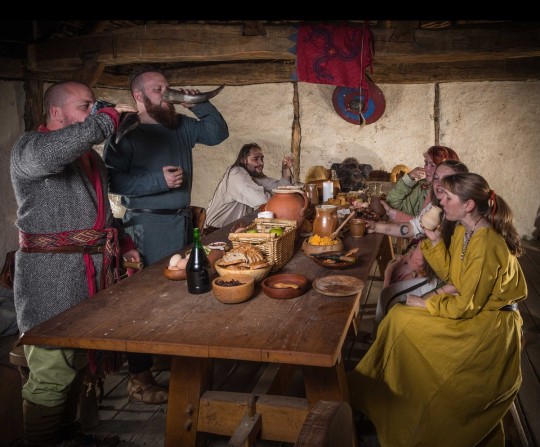

Feasting at Butser Ancient Farm
~ Migration period Anglo Saxon group, Herigeas Hundas enjoying an authentic feast in the Saxon Hall at Butser Ancient Farm over Eostre ~
Photos brilliantly captured by Ross Underwood
109 notes
·
View notes